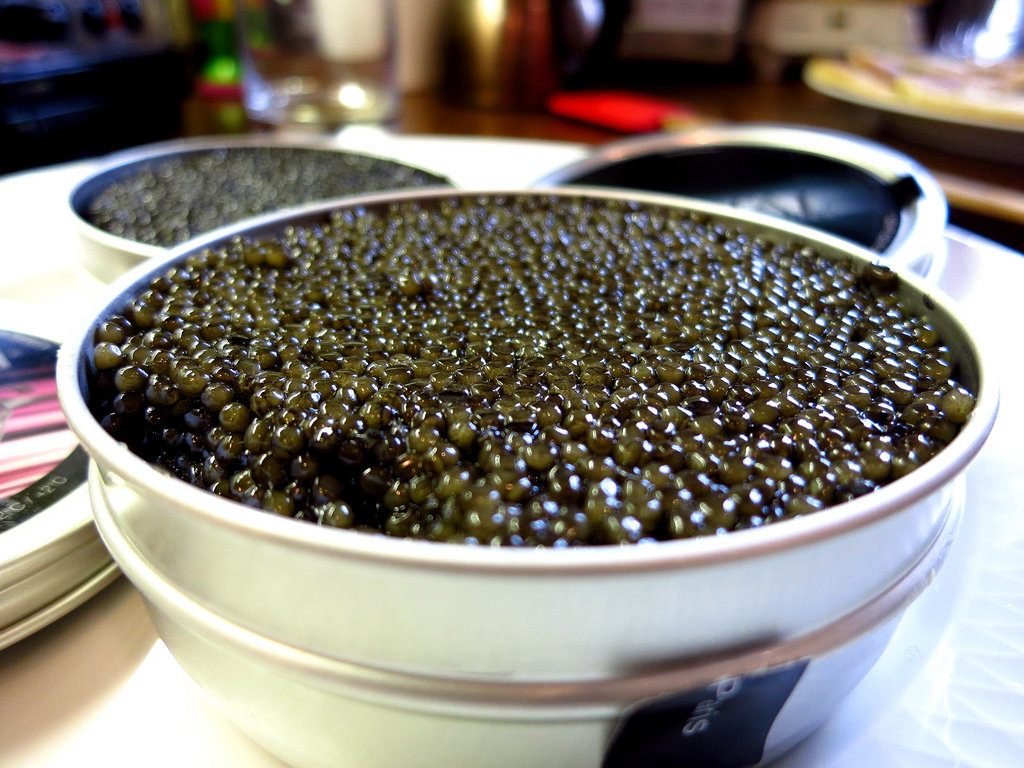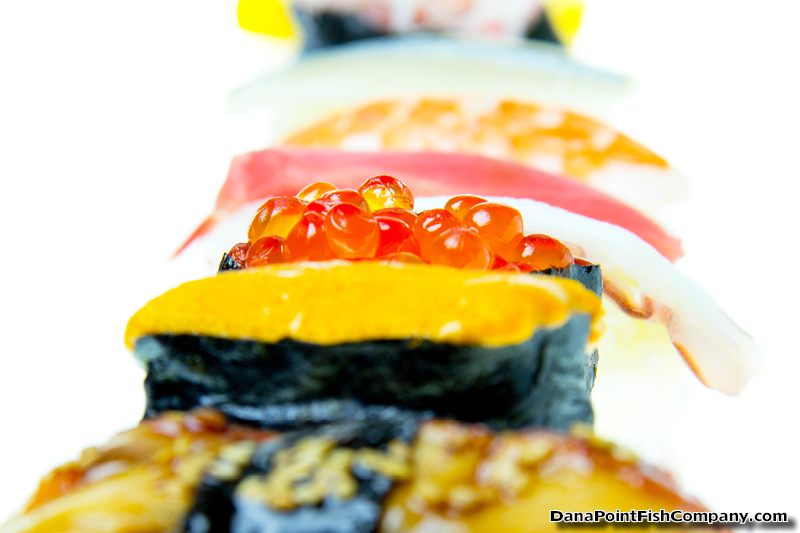Caviar is traditionally the salted, raw eggs of the wild sturgeon from the Caspian and Black Sea. Although caviar may used to describe many different varieties of fish roe, if the roe does not come from sturgeon then the fish needs to be identified in packaging, such as paddlefish or salmon caviar.
The fish species caught for traditional caviar are critically endangered. There is a current ban on Beluga caviar into the United States from the U.S. Fish and Wildlife Service, in place since 2005 that prevents the import and re-export of the threatened Black Sea basin beluga sturgeon caviar and the meat. Many alternatives for caviar are out there that are sustainable, just as tasty, and range in many different colors for all kinds of culinary applications.
How Caviar is Harvested
While wild Caspian caviar comes from endangered species, farmed caviar is a sustainable product. The methods for extraction is similar for different species.
Once the caviar is harvested from the fish (the ovaries removed and eggs collected), the eggs are gently separated from the membranes holding the egg sac together. This is typically done by gently pressing the raw caviar through a mesh screen. The eggs are then rinsed, cleaned, and drained. Salt is added (about 2 to 5% of the caviar’s weight) which helps with shelf life and the overall flavor. After a period of resting with the salt, the caviar is drained again, blotted dry, then packaged.
Three True Types of Caviar
There are three varieties of caviar that are considered the true types. Beluga, ossetra, and sevruga caviar all come from sturgeon that live in Caspian Sea.
- Beluga – Beluga caviar comes from the Beluga sturgeon, Huso huso. This sturgeon is the largest freshwater fish in the world, and very long lived at over 100 years. It is listed as critically endangered by the IUCN. Beluga caviar is traditionally the most expensive, and the individual roe is large and ranges from a pearl gray color to deep brown black.
- Ossetra – Ossetra caviar comes from the Russian sturgeon, Acipenser gueldenstaedtii. This sturgeon can grow to about 80 inches and weigh over 250 pounds, living to about 15 years. Wild Caspian Ossetra is critically endangered by the IUCN, but there are farmed alternatives available. Ossetra caviar ranges from light brown to olive gray to black. The indivdual roe is smaller than Beluga caviar, but larger than Sevruga.
- Sevruga – Sevruga caviar comes from the starry or Sevruga sturgeon, Acipenser stellatus. The Sevruga sturgeon lives to about 25 years. Unlike the Beluga and Ossetra, the flesh of the Sevruga sturgeon is also prized. It is critically endangered by the IUCN. The roe size is the smallest of the three true types of caviar, and the color is pearl gray.
Molossal Caviar vs. Pressed Caviar vs. Pasteurized Caviar
Caviar can be processed in different ways which directly affects the shelf life, flavor, and texture.
- Molossal caviar isn’t a variety, but rather describes how it was processed. It means the caviar was ‘lightly salted’, typically only having 3 to 3.5% of salt which translates to a better product but more expensive overall. The higher the salt content, the better the shelf life so Molossal caviar will have a shorter shelf life than other salted caviars with a higher percentage.
- Pressed caviar comes from very soft or burst roe which is pressed to a spreadable paste-like consistency. While it is a great way to use fish eggs that are broken during the traditional caviar making process, pressed caviar may also come from a blend of different fish to create a unique product.
- Pasteurized caviar is roe that is heat processed. It has more salt than fresh caviar. While some may consider this an inferior product, the pasteurizing process makes the caviar safe to eat for people needing to stay away from raw products, such as pregnant women.
Caviar Alternatives
There are many different alternatives to traditional caviar. These fish are sustainable and give you many choices for cooking and eating.
- Salmon Caviar – All salmon caviar is bright red or orange in color. This roe contains large, plump eggs that have a great flavor. Ikura is the Japanese name for salmon roe. Size and color of the individual egg is dependent on the salmon species: Chinook (King) salmon eggs are the largest and are reddish in color; Chum salmon eggs large and are reddish orange; Coho eggs are large and reddish pink; Pink salmon are slightly smaller and are orange in color; and bright red Sockeye salmon eggs are the smallest in size.
- Hackleback Caviar – Hackleback caviar is processed roe from the hackleback or shovelnose sturgeon, Scaphirhynchus platorynchus, which is found in the Mississippi or Missouri river systems. This caviar is small sized, with a black or dark brown color and good flavor.
- White Sturgeon Caviar – This roe comes from the largest freshwater fish in North America, the white sturgeon, Acipenser transmontanus. The caviar is black or nearly all black, with a flavor reminiscent of Ossetra.
- Tobiko / Flying Fish Roe – This is the sushi caviar, and is used mainly as a garnish or accompaniment to foods. The flying fish eggs are naturally an orange color and very small in size, but the roe can be dyed for appearance – wasabi for green; squid ink for black; beets for red; and yuzu for yellow. The texture is crunchy and holds up better than other roes (can be frozen, too).
- Lumpfish Caviar – Lumpfish caviar is processed roe from fish in the lumpsucker family, Cyclopterus lumpus. The caviar here is dyed black or red, and often pasteurized and packed into shelf stable jars.


